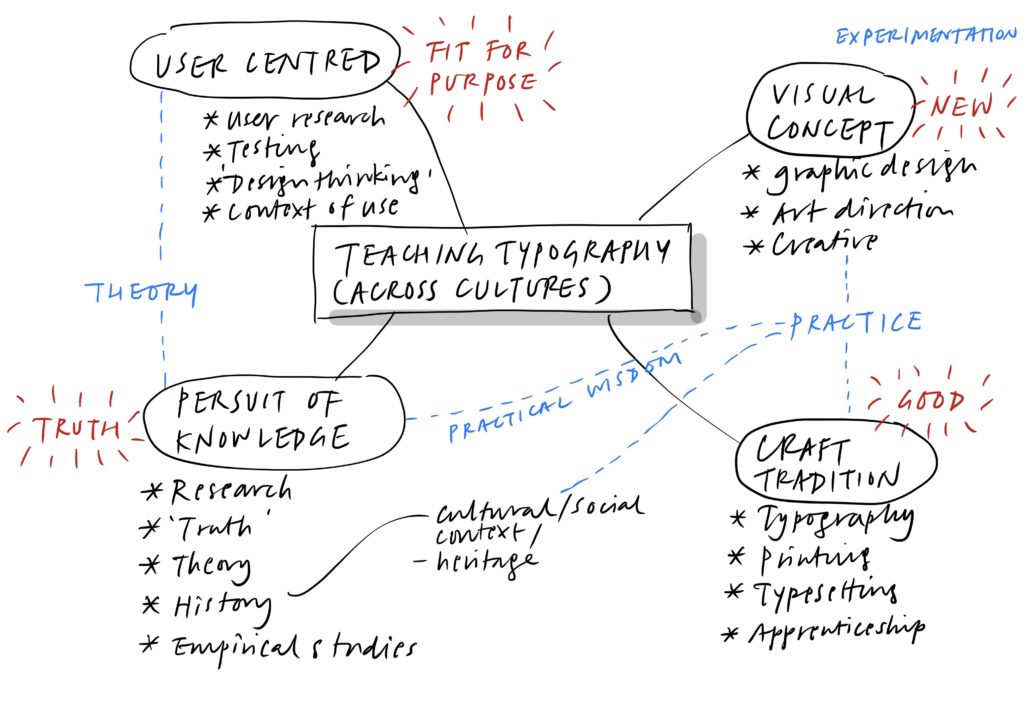
At the ATypI working seminars in Colombo, Sri Lanka, I shared my experience in teaching typography across cultures. My focus was not the differences between teaching in Canada, UK and Hong Kong (where I have taught), but the different perspectives of design education that are expressed in terms of believes, values and actions.
Typography teaching usually happens within the context of communication design education (or graphic design, visual communication). The degree to which typography is emphasised or valued in a specific programme varies. Some view typography as an expressive visual element, some view it as the most fundamental aspect of communication. Some see it as a technical skill (ie typesetting, desktop publishing), while others view it as a specialised area of academic study. The meaning of the term typography hence has many different interpretations.
I perceive at least four perspectives or ‘schools of thoughts’ of typography (and communication design) education, each one I have held to varying degrees throughout my teaching career so far. Let me briefly outline these four perspectives:
Visual concept: creating something new
This perspective typifies the art school ethos where the visual concept reigns supreme. Typography serves the purpose of making a concept visible, communicating a tone and manner, reaching a specified demographic, visually differentiating from competitors or persuading a specified audience to act on something. The key consideration is the emotive power of type and typography – extending the semantics of text beyond the literal – as well as aesthetic sensitivity, or indeed taste. This is a perspective widely held by graphic designers and art/creative directors, or those who work in the branding and advertising fields. Creating something new and original is the grand mission here. An iterative creative process is often adopted, and an apprenticeship approach to teaching that encourages experimentation. The typographer/designer is typically inward-focussed and self-driven, and is interested in pushing the creative envelope and coming up with novel forms. Those who excel under this mode of practice are rewarded with awards that recognise work with stylistic currency and formal innovation, and celebrated for their artistic flair and individuality.
Craft tradition: creating something good
The practices of typography was born out of letterpress printing, at least in the West. It has been inextricably linked to the craft and technics of printing. The training of typographers was through apprenticeship, and later in trade or technical schools. Before desktop publishing, typesetting and page composition were tasks that graphic designers had to outsource. Craft knowledge in typesetting was held mainly by typesetters and printers, as they were the ones who had access to the technology. This division of labour has now largely disappeared. The rules and conventions of typesetting was renewed with the coming of age of desktop publishing in the 1990s with sophisticated software and digital fonts, now a widely accessible technology. This craft tradition is still very much with us today in the digital age and is not restricted to print media. It is found in pockets within the practices of graphic design, book and publication design, typography, type design as well as niche letterpress printing. The emphasis here is to create artefacts that are inherently good – well crafted – rather than being new or innovative. Standards and values are upheld by communities of practice.
User-centred: creating something that fits the purpose
User-centred design is often associated with things that have very specific contexts of use, where effectiveness and performance are of utmost concern. Wayfinding systems, forms, instructions, user interfaces, documents, etc. are what practitioners of user-centred communication design focus on. A user-centric approach sprang from the human–computer interaction (HCI), web usability and information design fields, where the psychological aspects of the graphic presentation of information are studied. Affordances of graphic attributes – such as the legibility of typefaces, effectiveness of page layouts, user interaction of interface elements – are backed by findings from user research, informing design decisions. With digital transformation, typographers and communication designers increasingly blend their practices with that of information or user experience design, designing systems that enable content to be fed into that are usable and effective. The typographer/designer is outward-focussed and is empathic to others’ needs. Fitness of purpose is the key consideration here, with an emphasis on the logical rather than the novel.
Pursuit of knowledge: finding truth
Typography and communication design are first and foremost practice-based disciplines. Skills have traditionally been passed down from master to protégé through a ‘learning by doing’ approach. As typography and communication design became areas of academic study in formal education, internalised tacit knowledge held by masters (‘practical wisdom’) needed to be made explicit and transmittable. Reflections on practice and analyses of historical artefacts and documents are ways to understand the circumstances under which communications are produced, distributed and used: how processes are managed, how decisions are made, the social, cultural and economic contexts, technological influences, etc. Empirical studies that relate to the affordances of graphic presentation mentioned above is another area of research, sometimes using experimental and quantitative approaches with statistical analyses to verify hypotheses. Many avenues exist for the dissemination of research, including academic journals, conferences, trade publications, etc., though the degree which practitioners pick up on these vary. Regardless, research plays an important role in advancing knowledge of our profession, and the focus here is truth-finding.
What is your perspective?
My aim here is not to generalise; it is merely a reflection on my own practice as a practitioner, teacher and researcher. These four perspectives do not exist in isolation of course. An educator or practitioner may hold these perspectives simultaneously or move fluidly between them without even realising. Or they might deeply hold one perspective and practice only in that realm. Different types of educational institutions might also hold one (or more) of these as their primary value.